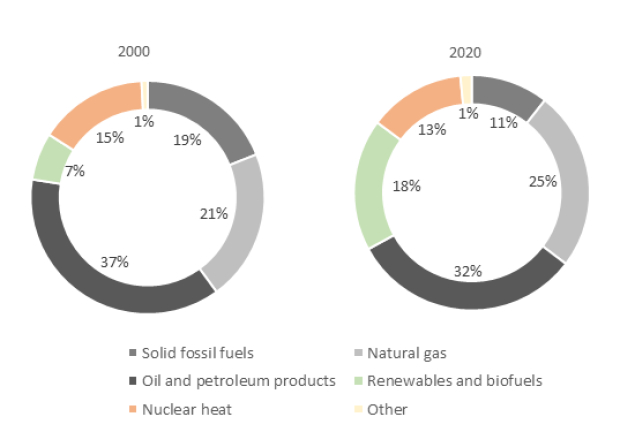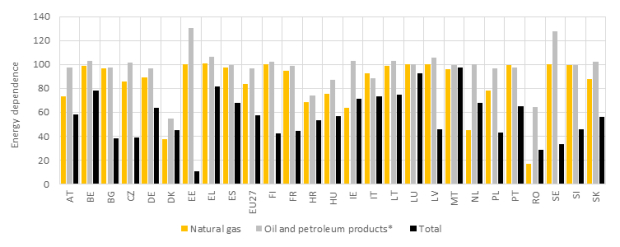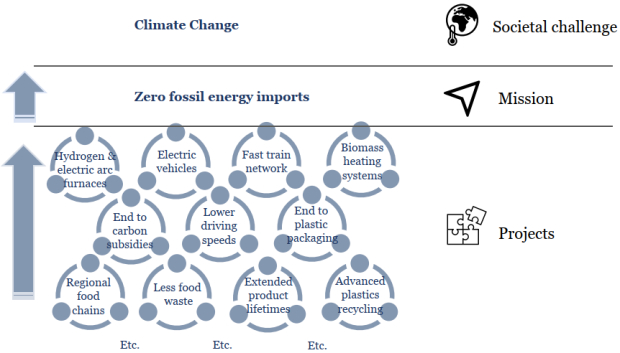The EU’s most urgent industrial mission: Zero imports of fossil energy
29 March 2022
The war in Ukraine dramatically underscores the fact that zero net imports of fossil energy is the EU’s most urgent industrial mission.
image credit: unsplash.com/Nazrin Babashova
- The EU faces three main challenges: achieving carbon neutrality, addressing its lack of strategic autonomy and attaining technological leadership
- A carbon neutral economy requires an energy transition which needs to be guided by a well-defined industrial mission.
- The appropriate mission is to achieve carbon independence defined as zero fossil energy imports.
- The zero fossil fuel import mission serves primarily to decarbonise the EU economy but has a geopolitical component which history shows increases the probability of success.
The atrocious war Russia is waging on Ukraine is a human catastrophe and needs to be stopped as quickly as possible with non-military means. In this vein, the EU is betting on economic sanctions and running down trade relations. The success of sanctions is far from a safe bet but if this instrument is invoked, oil and gas need to be targeted. So far, the EU has– in contrast to the US – shied away from stopping gas and oil imports from Russia. The reason for this restraint is obviously the EU’s much greater dependence on Russian oil and gas, and especially the lack of alternative gas supplies given the path dependency created by pipeline infrastructure. This most effective move – stopping Russian energy imports – could come at a very high cost to the economy of the EU. Put differently, the EU faces the problem that it is unable to pursue its preferred foreign and economic policy in line with its interests and values. This illustrates that the EU still has a long way to go when it comes to strategic autonomy. Against this background this article emphatically reiterates the call for carbon independence we published in February 2020, defined as an ‘industrial mission’ (for industrial missions see here and further below):
“to make the EU carbon-independent, meaning zero imports of petroleum, natural gas and coal. As the EU is currently a huge net importer of these commodities, numerous innovations, a complete change of the current energy system and technological adjustments would be necessary […] to achieve the proposed mission.”
Our intent is not to lament the inaction and mistakes of the past. Rather we argue that the way forward for the EU to regain the policy space required to achieve this aspired open strategic autonomy and avoid conundrums of the kind it is facing right now, is to realise this goal. We shall concretise that the mission should be completed by 2030. As we shall demonstrate, this mission would make a substantial contribution to the ecological transformation and is fully aligned with the European Green Deal. The mission shall also ensure the worst case scenario, which would be to cede to the temptation to postpone overdue climate measures (such as proper carbon pricing) or prop up fossil fuel subsidies in reaction to the short-term economic pains imposed by the energy price shock. Equally detrimental would be to seek the solution in the construction of yet another pipeline. Instead of this ‘more-of-the-same policies’ approach, a combination of new technologies in the field of energy generation as well as in industrial processes and, where necessary, changes of behaviour in energy consumption are urgently needed. Without forgetting about the human suffering caused by the war in Ukraine, it should at least serve as a catalyst for starting the green transition in earnest.
Why zero net fossil energy imports?
The energy system is at the core of a carbon free economy. 25 years after the Kyoto Protocol, the EU is still a carbon-based economy. A myriad of reports by the Intergovernmental Panel on Climate Change (IPCC) warning about global warming (currently estimated to range from 1.2% to 3%, depending on the scenario), a plethora of meetings of the Conference of the Parties (COP) of the United Nations Framework Convention on Climate Change (UNFCCC), the Paris Agreement and countless European Commission Communications on climate change and climate actions so far have not drastically altered the EU’s energy system. In 2020, more than two thirds of the EU’s total energy supply was still coming from fossil fuels, including solid fossil fuels (coal), oil and petroleum, and natural gas (Figure 1).
Total energy supply in the EU by primary energy source, 2000 and 2020
Note: ‘Other’ includes electricity, oil shale and oil sand, peat, heat and non-renewable waste. The total energy supply is composed of primary production plus recovered & recycled products plus (imports minus exports) plus stock changes; less International maritime bunkers, less International aviation. Source: Eurostat (nrg_bal_c), own calculations.
While this constitutes a decline from 77% in 2000, at the current pace of change it will take the EU more than 90 years to become a carbon (and hence emission) free economy. This is obviously incompatible with the European Green Deal’s objective of a “modern, resource-efficient and competitive economy where there are no net emissions of greenhouse gases in 2050 and where economic growth is decoupled from resource use” (European Commission, 2019, p. 2). Current measures such as the European Emission Trading System (ETS) and regulatory measures are important in this respect but address only energy generation and production processes within the EU. The fundamental problem is the EU’s massive fossil energy dependence on foreign suppliers (Figure 2).
Member states’ energy dependence in 2020
Note: Energy dependence is defined as net imports / gross available energy. Net imports are calculated as total imports minus total exports. Gross available energy is composed of primary production plus recovered & recycled products plus (imports minus exports) plus stock changes. Values exceeding 100% indicate an accumulation of stocks. * excluding biofuel portion. Source: Eurostat (nrg_ind_id).
The problem is twofold. First, impressive shares of renewable energy production in total production, which EU member states like to brag about, are misleading, if close to 60% of total energy consumption is imported. This is particularly true if this import dependence stems from the import of fossil energy. Second, the majority of energy imports from third countries originates in countries and regions with considerable political risk. For example, less than a third of the EU’s extra-EU imports of natural gas are imported from ‘secure suppliers’ defined to include Norway, the UK and the US. In contrast, more than 40% are from Russia, with Algeria, Qatar and Nigeria being other important suppliers – none of which can be considered flawless democracies. Therefore, the quest for alternative suppliers is likely to get the EU out of the frying pan into the fire. In the short-term, arrangements with supplier countries such as Norway or the US may be necessary to ensure supply security, which is the major constraint and the greatest threat to the success of the mission. In the medium to long-term, however, the solution can only be the realisation of the green transition. The latter requires an active industrial policy which bundles projects into a single mission: eliminate all fossil energy imports.
Industrial missions to the rescue
Industrial missions are a strategic industrial policy tool with which industrial policy addresses societal challenges. More precisely, missions are the operational stepping stone that link individual (innovation) projects to master grand societal challenges (Figure 3). A mission comprises a myriad of individual projects, all of which serve its achievement. Importantly, the suggested mission is fully consistent with EU policy priorities as it supports the green transition, fosters the EU’s strategic autonomy, and supports firms in attaining technological leadership.
The main characteristics of an industrial mission are measurability and granularity (see Mazzucato, 2018). The former means that the success or non-success of the mission must be unambiguously established. The Apollo mission gives the idea. Either men land on the moon and return safely – mission achieved – or not. The suggested mission of zero fossil energy imports clearly satisfies this criterion. Whether or not there are fossil energy imports into the EU or not can be easily read in the balance of payments. Likewise, it has the ‘right’ granularity, insofar as it is large enough to make a substantial contribution to solving the societal challenge it addresses. The significance of the mission is undisputable. The task consists of substituting 33,000 Petajoule (PJ) of fossil energy imports. This represents 60% of the EU’s total energy supply and 81% of final energy consumption (all figures refer to 2020). Adjustments are possible along at least four dimensions: increasing domestic production, increasing imports of renewable energy, reducing consumption, or making energy generation more efficient. This opens up considerable policy space including the expansion of existing alternative energy sources, new technologies and changes in consumption behaviour. The emphasis on physical units as opposed to monetary units is intended. This is because what will decide the success or failure of the mission will be primarily supply security. And to a much lesser extent the price of energy (which is bound to increase anyway during the transitory phase towards a non-fossil energy system).
In this context it should be mentioned that the geopolitical component inherent in this mission could increases the probability of success. This is all the more true in light of the urgency imposed by the Russian aggression against Ukraine. In fact, the success of the Apollo mission can beat least partly attributed to ideological rivalry during the Cold War, which helped mobilise the necessary funds to finance the mission.
The zero fossil energy imports mission
Source: Own elaboration based on the concept in Mazzucato (2018).
Making the mission a success
A proper definition of the mission is half the battle. Turning it into a success, however, will require a plethora of innovative projects. This includes above all innovation projects that deliver new technologies which make fossil fuels dispensable. A good example would be hydrogen and electric arc furnaces in the production of steel, technologies in which pilot projects are already running. E-Mobility would be another important example. For both, the development of hydrogen-based technologies as well as batteries, the EU (respectively interested member states) has launched so-called Important Projects of Common European Interest (IPCEI). IPCEIs are in essence a relaunch of the grands projects of the 1960s and 1970s, lifted to the European level. Hence, the industrial mission is also supportive of yet another EU major policy objective, which is to attain technological leadership across a variety of environmental domains. The innovation projects, some of which will be successful, some of which will fail, ought to be supplemented by ‘regulatory’ innovation. This covers a potentially wide array of measures including extended guarantees and warranties for consumer products and the prohibition of planned obsolescence which would certainly help extend product lifetimes.
A quick fix would be the reduction of speed limits on European roads. We shall make an important note at this stage. The individual contribution of a single project may be small, but this is no reason not to realise a project. As long as it serves to achieve the mission, it should go ahead, especially if it entails no financial costs. In contrast, existing measures that run counter to the mission, such as fossil fuel subsidies (including tax exemptions), are to be discontinued. This is especially important because if the objective is to master the ecological transition in order to mitigate global warning, there should be a carrot-and-stick approach: carrots for carbon energy free activities and sticks for fossil energies. Currently, policy makers all too often follow a carrot and carrot approach, meaning incentives for antagonising objectives (fossil energies vs. renewable energies, individual transport vs. public transport, etc.). This thwarts the effectiveness of either measure and inevitably results in the waste of public money. Moreover, time is a crucial factor so that any impediments to the ecological transition should be removed as quickly as possible.
Conclusion: Europe’s man on the moon moment is now
The Russian invasion of Ukraine exposed the EU’s energy dependence. This dependence is highly unsatisfactory from an economic, environmental and humanitarian perspective, as it undermines true strategic autonomy so that, in contrast to the US, the EU continues to purchase oil and natural gas from Russia, thereby directly financing Russia’s military operations. The mission we propose – the curb of all fossil energy imports until 2030 – aims to mitigate climate change, the most pressing societal challenge of our time, while at the same time enabling the EU’s strategic autonomy (be it open or not). Importantly, the phasing out of all coal, oil and gas imports would free the EU from its energy dependence without provoking Russia, as imports from all foreign suppliers would be gradually reduced. The catch –in the short term – is energy supply security. Some short-term measures may be needed in this respect. However, measures that risk derailing the ecological transition (such as scaling up fossil fuel subsidies under the pretext of welfare measures) must be absolutely avoided. Hence, the challenge is to come up with alternative technologies, a different set of regulations and tax rules and probably also changes in consumer behaviour, in order to ensure energy security in the absence of fossil energy imports. If successful, this mission will make a major contribution to climate change mitigation, enliven the concept of strategic autonomy, and support the technological leadership of EU firms. The entire mission may seem unrealistic in view of the seemingly unsurmountable security of supply constraint. But just as the Covid-19 pandemic brought about a massive digitalisation push, one could imagine the war in Ukraine pushing the energy transition. There is always an alternative.
Links:
Landesmann, M. and R. Stöllinger (2020), The EU’s Green Deal, laudable as it is, will not be enough to trigger the desired ecological transformation, 3 February 2020. Available at: https://wiiw.ac.at/the-european-green-deal--good-intentions-that-won-t-go-far-n-423.html.
IPCC (2021), Climate Change 2021. The Physical Science Basis, Working Group I Contribution to the Sixth Assessment Report of the Intergovernmental Panel on Climate Change. Available at: https://www.ipcc.ch/report/ar6/wg1/downloads/report/IPCC_AR6_WGI_SPM_final.pdf
European Commission (2019), ‘The European Green Deal’, Communication by the Commission, COM(2019)640 final, 11 December, Brussels. Available at: https://eur-lex.europa.eu/resource.html?uri=cellar:b828d165-1c22-11ea-8c1f-01aa75ed71a1.0002.02/DOC_1&format=PDF
Stern: Climate change a 'market failure', The Guardian, 29 Nov 2007. Available at: https://www.theguardian.com/environment/2007/nov/29/climatechange.carbonemissions
Mazzucato, M. (2018), Mission-Oriented Research & Innovation in the European Union. A problem-solving approach to fuel innovation-led growth. Available at: https://ec.europa.eu/info/sites/default/files/mazzucato_report_2018.pdf



